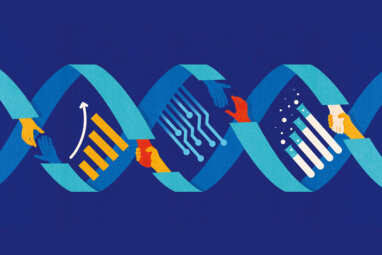How to Turn Professional Services Into Products
Product-based business models can help services firms achieve greater scale and profitability. But the transformation can be challenging.

David Plunkert/theispot.com
Product management is one of the fastest-growing roles in business, having gained increased scope and importance in Silicon Valley. While product managers used to be hired almost exclusively by technology companies, they are now being recruited in growing numbers by service-oriented businesses as well, with firms such as Accenture, Chase, JPMorgan, Optum, and Vanguard adding product management functions in the past few years. Why are services companies looking to add product capabilities to their organizations?
Professional services firms, which span a wide range of sectors, including IT, legal, marketing, and tax and accounting services, face two major growth challenges. Owing to the significant human involvement in service delivery, their gross margins are low, and their head counts scale linearly with increases in revenue. Product companies enjoy much higher growth margins and revenue per employee. This explains why startups that offer software-as-a-service products are valued at six to eight times their annual revenues, whereas startups that offer project-based services are valued at one to two times their annual revenues.
Recognizing the challenges of margins and scalability, professional services firms are trying to evolve into product-like companies by productizing their services. This involves automating, standardizing, and packaging aspects of a service into a tangible, repeatable, and scalable offering that is efficient to produce and easier to scale.
Consider, for example, Littler Mendelson, the largest labor and employment law firm in the United States, which has developed a proprietary platform that productizes aspects of legal case management. Littler CaseSmart combines a case management system with a network of specialized attorneys who use it to deliver legal services more efficiently and provide clients with a more predictable cost structure and faster access to case information and analytics. The platform’s dashboard provides real-time tracking of legal matters, documents, and deadlines and offers insights into litigation trends. This digital product has allowed Littler to deliver legal services at scale, improve client outcomes, and enhance its ability to manage a high volume of cases effectively.
Unlike bespoke services that are highly customized for each client, productized services can be standardized and delivered repeatedly to multiple customers with similar needs. (See “Benefits of Productizing Services.”)
Strategic Challenges in Productizing Services
Turning services into products can be a lucrative pursuit, but it is fraught with operational and organizational challenges. Leaders of professional services firms must consider several difficult questions about whether their service offerings can and should be productized and for which customer segments, and how to transform a service-oriented business into a product-oriented one.
Answering these questions will set up business leaders with a five-step productization road map.
- Assess the product potential. To what extent can the service be productized?
- Decide the optimal productization level. To what extent should the service be productized?
- Define the offering portfolio. What product-service mix should be offered to different customer segments?
- Build the product capabilities. What are the enablers of productization, and how can these be leveraged to drive the productization process?
- Lead the transformation. How should the productized organization be designed, and how can the barriers to change be overcome?
Turning services into products can be a lucrative pursuit, but it is fraught with operational and organizational challenges.
STEP 1: Assess the Product Potential
Every professional service involves a series of activities or tasks executed by the service provider in collaboration with the client. Consider claims processing for auto insurance. This process includes a series of steps in sequence: notification of loss, claim information collection, claim registration, claim verification, claims adjustment, claim investigation, liability assessment, damage valuation, claim resolution, claim payment, subrogation, and claim fraud prevention. For each activity, the service provider should define two criteria:
- Frequency: How often is each activity conducted? How repeatable is the activity? Frequency and repeatability are important because automating activities using AI and machine learning requires rich training data. The more frequent the activity, the richer the data available to train algorithms that will automate the process and the greater the potential productivity improvement that can be realized by substituting human effort with automation.
- Cognitive complexity: How much cognitive skill is required to perform the activity? Does decision-making require significant domain and process expertise or straightforward heuristics? What are the likely economic consequences of making a poor decision? The more complex and mission-critical an activity is, the more difficult it is to automate and delegate to an algorithm.
These two criteria jointly determine the product potential of the service, which varies significantly across sectors based on the repeatability and the cognitive complexity of the activities and tasks involved. In the case of auto insurance claims processing, all of these activities occur with very high frequency, and many of the activities involve straightforward decisions. Therefore, auto insurance claims processing has a high product potential. Auto insurance companies have embraced productization, including Lemonade’s AI-driven claims-processing system, called AI Jim; State Farm’s AI-based image-recognition system to assess vehicle damage; and Progressive’s Snapshot tool, which uses telematics data to assess driving behavior and assist in claims processing.
In contrast to auto insurance claims processing, strategy consulting is an infrequent practice that relies heavily on human expertise and judgment. Close client contact is important, and the cognitive complexity of strategy consulting services is high. While some activities, like industry analysis, data analysis, and task benchmarking, can be automated with generative AI tools, the product potential of strategy consulting services is low.
Consider the case of MarketEngine, which offers an array of marketing services to startups. Some of its activities are highly collaborative and strategic, with high cognitive complexity. Marketing strategy development, for example, involves defining marketing goals, customer segments, value proposition, positioning, messaging, KPIs, and marketing budgets. These activities are performed infrequently, often on a quarterly or annual basis. The company also offers content creation and email campaign design services, which are highly repeatable and frequent activities involving simpler decisions. Those activities can also be automated via content creation tools and platforms that automate campaign execution and thus are the most likely candidates to be turned into products.
STEP 2: Decide the Optimal Productization Level
The product potential for a service considers only the supply side of the service, with a focus on how business processes can be productized to be accomplished more effectively. However, services firms also need to consider the demand-side perspective by assessing the extent to which the service should be productized based on customer behavior and preferences. Even though certain service activities may be easily productized, some clients may want high-touch customer engagement and vendor contact. Customers differ in their preferences for high touch versus zero touch, based on their capabilities and priorities. Consider investment advisory services. Price-sensitive investors who are satisfied with a limited array of options can be served with an offering such as Vanguard’s automated Digital Advisor, which monitors and corrects clients’ asset allocations and advises on certain tax implications. However, Vanguard continues to offer the services of personal investment advisers for more sophisticated investors with more complex advisory needs and larger investment accounts.
Any decision to productize a service should consider both its supply-side and demand-side potential. Returning to the example of digital marketing services, we can estimate the optimal productization level by assessing the level of engagement that customers want for various activities and factoring in the supply-side potential assessed earlier.
STEP 3: Define the Offering Portfolio
If customers have relatively homogenous preferences for the value they place on engagement with the services provider, a single offering can be created for all customers at the optimal productization level. However, if customers have heterogeneous preferences for human engagement, the services provider needs to have a portfolio of offerings featuring different levels of productization. These can include a “do it for me” high-touch option, a “do it with me” medium-touch option, or a “do it myself” low-touch option. The more diverse the customers are in their preference for touch, the more differentiated the offering portfolio will need to be.
If customers have heterogeneous preferences for human engagement, the services provider needs to have a portfolio of offerings featuring different levels of productization.
In the case of MarketEngine, customers are clustered into two distinct segments: smaller, Series A startups with less than $2 million in annual revenues and fewer than 50 employees; and larger, Series B startups with revenues between $10 million and $50 million and over 100 employees. Series A startups have relatively simple and standardized needs and lack the budget to pay for high-touch marketing services. For these customers, MarketEngine has created a highly productized offering featuring a mostly do-it-yourself product with a small services component for the strategy formulation phase. Even the strategy formulation process uses generative AI to summarize strategy discussions with clients, create marketing plans, and determine the marketing channel mix for the client.
For Series B startup clients, which have larger budgets and more complex needs, MarketEngine has a “white glove” offering. It features close collaboration between its digital marketing consultants and the client’s marketing executives, who value the higher level of expertise and personalization.
STEP 4: Build the Product Capabilities
Productization of services requires three capabilities:
- Domain expertise to understand process workflows.
- Proprietary data to train AI algorithms.
- Technology platforms for automating processes and harnessing AI/generative AI.
Domain expertise is the starting point for productization of a professional service. You cannot automate something you do not understand in depth and detail. A nuanced understanding of industry business processes is essential to identify opportunities to productize and embed automation into the workflow.
The second enabler of productization is data, which fuels the automation engine. Machine learning algorithms require large amounts of high-quality training data. For instance, a legal services provider seeking to automate the legal contract review process will need access to thousands of contracts from different jurisdictions that represent different contract types and levels of complexity.
The third enabler of productization is technology platforms that automate tasks using software. For instance, in digital marketing, tasks like email campaign execution, lead management, and search engine optimization can be aided with marketing automation platforms like HubSpot, MailChimp, and Segment.
Transforming a service to a product can be a slow journey that takes several years. Consider the development of FuelTrans by Bahwan CyberTek (BCT), a global IT services company based in Oman. In 2013, BCT embarked on an IT services project for Oman Oil Marketing Co. (Oomco) to solve business problems in its oil retailing business. The client’s problems included a lack of visibility of wet stock inventory, fuel pilferage at gas stations, long lead times in financial reconciliations between stations and the head office, and misuse of fuel subsidies provided by the Oman government. BCT developed a bespoke services-intensive solution for automating the retail operation for Oomco. The bespoke solution gathered data from internet-of-things devices at Oomco service stations to transmit data to the head office. The solution was successfully rolled out to 176 Oomco stations across Oman. As BCT gained more experience with the process workflows in downstream oil retail operations, it expanded the solution to integrate the terminal automation systems with Oomco’s back-end enterprise resource planning system — a solution that was able to automate many of Oomco’s operations from end to end.
In 2015, BCT decided to leverage its data and domain expertise to develop a standardized product called FuelTrans. The product included components for managing automation for fuel stations, supply chains, logistics, and convenience store retail operations.
By moving from a bespoke services project into a standardized product, BCT was able to offer a well-defined set of features and pricing to multiple customers. As a result, the company was able to acquire large customers across multiple markets in India, Africa, and Southeast Asia. As of October 2023, FuelTrans had been installed in over 13,500 stations worldwide, making it the fourth-largest player in fuel system automation globally. The FuelTrans product allowed BCT to scale rapidly across customers and markets, which would not have been possible with a project-based services offering.
STEP 5: Lead the Transformation
Turning services into products can drive significant increases in revenues and profits for professional services firms, but it involves a difficult business transformation. To lead the transformation, business leaders must be aware of the challenges and should proactively adopt strategies and tactics to overcome them.
The dominant culture and mindset of professional services firms can be one major roadblock to transformation. These firms typically take on a project and bill for it immediately after completing the work. They balk at the prospect of investing heavily in product development in the hope of uncertain payback after several years. Leaders must understand that a product culture is very different from a services culture, in terms of its focus on long-term investments, customer jobs to be done, cross-functional execution, and agile development. Therefore, leaders of services firms must educate, communicate, and evangelize this new mindset and culture.
The dominant culture and mindset of professional services firms can be one major roadblock to transformation.
Productization requires a services firm to develop new product management capabilities and a new team. This can be done more quickly with a separate product organization, for which product management talent hired from outside is most likely to have the necessary expertise and mindset. The product management organization must initially be kept separate from the core services organization so that it can create its own practices and processes needed to build and market products, before being gradually integrated into the core business.
Product organizations also require very different KPIs, incentives, and career paths than service organizations, which are focused on billable hours, rates, and new-client acquisition.
An additional challenge is that these products are often “embedded” components of a service and are not sold as products, making it difficult to calculate revenue generated by the productized service. For embedded products, KPIs must be linked to the improvement in productivity, customer satisfaction, or customer retention that is attributable to productization.
The final challenge is the redesign of the business model. When services are productized, the standard time-and-materials business model used by professional services firms must be modified to allow for transaction- or outcome-based pricing. For example, if an audit firm were billing its clients by the hour for its services, it would not want to be paid less for productized auditing services that could be provided more quickly. Productized audit services should instead be priced on a per-task, per-document, or per-audit basis.
Although the productization of services has been gaining traction for years, its full potential has yet to be realized. By following the road map above, leaders of professional firms can navigate the challenges in realizing the promise of improved margins, greater scalability, and enhanced competitive advantage that productization offers. In the process, productization allows a greater number and wider range of customers to more easily access services that were previously out of their reach.









Comments (2)
Contacto Asesori
Lalo Lopez